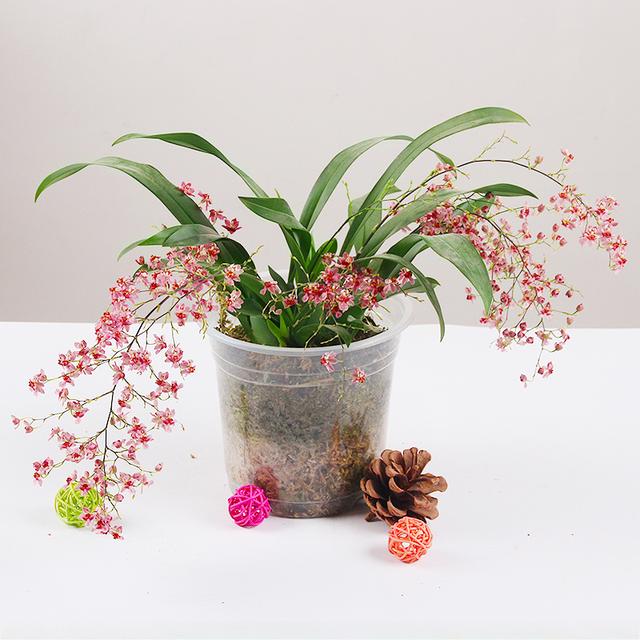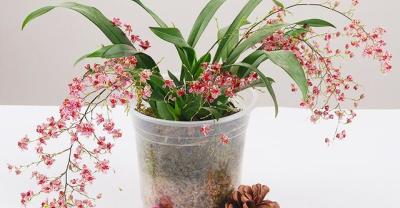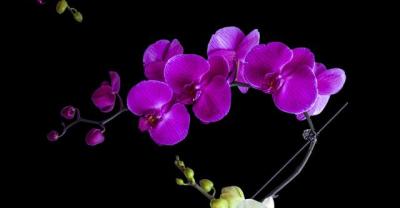Common orchid species and small techniques for orchid maintenance
Common orchid species and small techniques for orchid maintenance
The orchid, as the "four gentlemen in the flower" of plum orchid bamboo chrysanthemum, is more graceful in shape, vitality and environmental adaptability than most flowers and plants, and has always been a common flower in horticulture. At present, there are about 500,800 genera and tens of thousands of species of Orchidaceae in the world, of which 15 genera are common.
1. Common orchid varieties
(1) Oncidium is distributed in Mexico, Brazil and other tropical America, there are about 300 species, from small to large, the color is mainly yellow to brown system. It is also known as "dancing orchid" because the flowers are like girls dancing in a puffy dress. This lovely little orchid has leaves only 6cm long and more than 2cm in diameter, with fine spots or blocky markings on its petals. It has many related genera, among which spider orchid is named for its flower shape such as long-legged spiders.
(2) Dendrobium can be found in Japan, Korea, China, Thailand, Vietnam, Philippines, Malaysia, Indonesia, Australia and New Zealand. There are more than 1 500 original species and the flower morphology is very varied. The most common feature of Dendrobium is that the left and right lateral calyx of the flower are folded into a chin shape. In this feature, there are a variety of flower posture, such as the waterfall growth of "Dendrobium candidum".
(3) Wandailan "Wandai" is taken from the Sanskrit word "Vandaka", which means "born on trees". There are more than 70 original species, most of which are large varieties except a few of them are mini. Most orchids can plant more than a dozen flowers on pedicels and blossom almost all the year round. The color of the flower varies from white, yellow, green, red to blue, some twisted and reversed, some round and flat.
(4) Cadelia Arran has large flowers, beautiful colors and a wide variety, so it has the reputation of "king of orchids". The country of origin is Central and South America, there are a number of varieties, such as single-leaf type, double-leaf type, multi-leaf type; there are also large species, mini species. Generally speaking, single-leaf species usually have larger flowers and more beautiful, wider petals, while double-leaf species have smaller flowers and narrower petals, and usually have more obvious colors and flowers.
(5) the flower posture of Phalaenopsis gets its name from dancing like butterflies, especially when it blossoms, the stem of the flower hangs into a bow, and the breeze blows like a group of butterflies, so it is known as "after the orchid". The flowering period is as long as 2-4 months, but through modern cultivation techniques, the flowers can be seen in full bloom almost all year round. There are about 50 native species, most of which grow in Indonesia, Philippines and other countries, and are suitable for growing in high temperature (about 25-30 ℃) and humid environment. It is drought-tolerant and shade-tolerant, so it is suitable for cultivation in courtyards and roof balconies with insufficient sunshine.

2. Small technology of orchid maintenance
(1) maintaining the ventilation of the ventilated environment and the cultivation medium (charcoal, bark, sawdust, etc.) are the main factors to consider, and the quality of air permeability is the first element, and then consider the problem of water retention.
(2) do not overwater and overuse fertilizer orchids have good drought resistance. They would rather be watered less than too much. Too much watering will lead to rotting roots. In order to avoid harming the plant, thin fertilizer is the right way to apply fertilizer.
(3) do not plant too deep. Most orchids are exposed except for their roots. Deep planting will lead to muggy or wet buds. For a plant that is unstable, fix it with a pillar instead of burying it deep.
(4) the light should be sufficient for each kind of orchid. The method to judge whether the light is appropriate is that the plant color becomes lighter or yellow, that is, the light is too strong, and the plant gradually turns dark green means that the light is insufficient.

- Prev

Successful orchid farming starts with knowing the roots of orchids
Orchids belong to higher plants, like other higher plants, orchids are also composed of roots, stems, leaves, flowers, fruits and other parts. We grow orchids from...
- Next

How to consider the location of orchids when growing and cultivating orchids?
The formula of cultivating orchid is "Qi". From the selection of cultivation materials to the determination of placement position, ventilation should be considered first. Some people sum up the habits of orchids into three sentences.
Related
- Is the orchid suitable for indoor use? Is it good for the body?
- How to prevent the empty root of orchids?
- What to do after the crab claw orchid is withered?
- Why are the leaves of orchids always yellow? Fertilizing and watering.
- Can the root of the gentleman orchid be saved if it is rotten?
- Diagnosis and treatment of cotton-blowing beetle insects in Cymbidium
- There is a way for a gentleman's orchid to rot.
- What is the most suitable temperature and humidity for the orchid?
- How to raise a gentleman's orchid? Cultivation techniques of Cymbidium
- How to prepare the nutritive soil for the cultivation of Cymbidium

